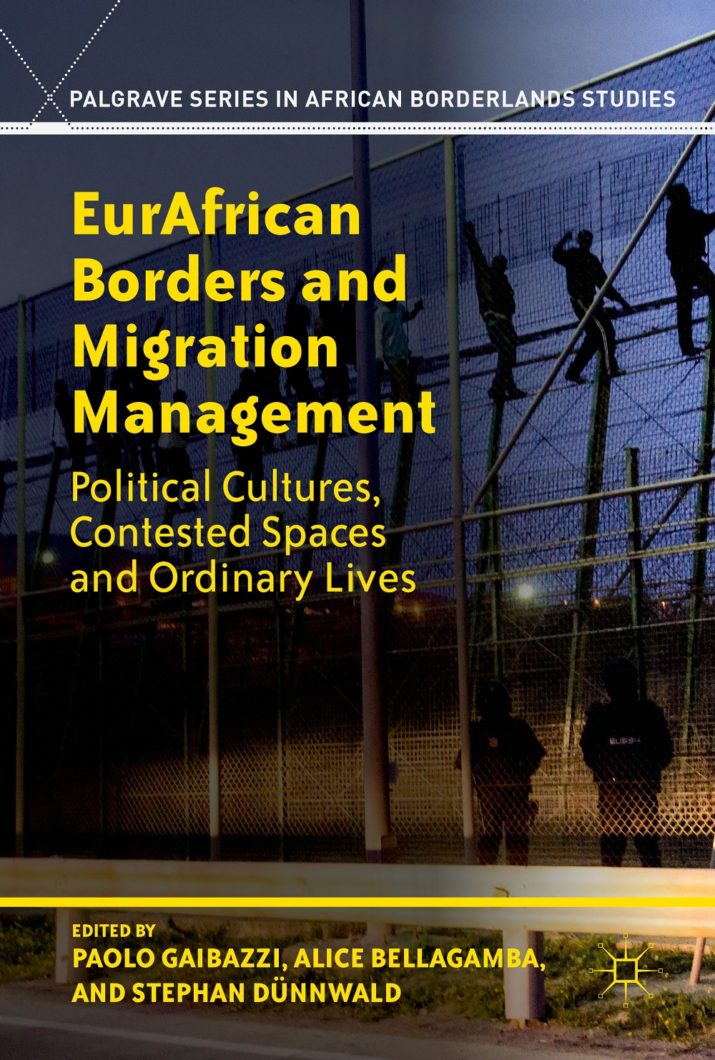
EurAfrican Borders and Migration Management: Political Cultures, Contested Spaces, and Ordinary Lives edited by Paolo Gaibazzi, Alice Bellagamba, and Stephan Dünnwald

This is part of our special feature Governing the Migration Crisis.
Borders are political and economic, material and subjective, hard and soft. By their very nature, borders are gendered, classed, and raced in important ways. Yet, they are also emergent and relational, rather than being fixed and hegemonic. The recently published volume on EurAfrican Borders and Migration Management, edited by Paolo Gaibazzi, Alice Bellagamba, and Stephan Dünnwald, takes the case of territorial borders between Africa and Europe to elaborate how such frontiers, and the cultures they inspire, are also emanant, collaborative, and contested. Parting ways with the traditional approach to national boundaries, which often privileges the assumed sovereignty of the state, the various authors here try to grasp how bordering practices are embedded in specific power relations between European and African states, stakeholders, and migrants. In light of the recent “refugee crisis” in the Mediterranean, borders are increasingly on the minds of scholars and policy makers alike. However, as the editors note in the Introduction, seeing European borders as strictly European phenomena misses the ways in which they are distinctly co-produced through European and African negotiations. European frontiers, and the mechanisms used to defend them, are increasingly thought of as “externalized,” or offshored to Africa. In this way, Europe’s borders are seen to be moving increasingly south through policy transfers, bi-lateral agreements, and burden sharing initiatives that seek to police and protect Europe from beyond the territorial limits of the Schengen Area. Although scholars like Sandra Lavenex have been writing about externalization since the mid-2000s (Lavenex 2004; Lavenex 2006; Lavenex and Uçarer 2004), such literature has been focused primarily on policy analysis from a predominantly European perspective. What this volume offers is a more intimate look into not only the ways that bordering practices are co-produced between European and African states, but also how people and places are reconfigured by such processes.
In the Introduction, the editors propose the heuristic of EurAfrican borders as a way to capture analytically how “Europe’s external borders have also become African borders” (10). Their goal is to unpack the seemingly binary dyad of insider-outsider, national-foreigner by looking at the genealogy of border relations. “Europe’s externalization of border and migration management toward Africa,, they comment, “writes a new chapter in a long history of intertwined and concomitantly unequal trajectories between the two continents, as well as by stark power inequalities, colonial domination, exploitation and racial discrimination” (11). At the same time, Africans are not passive victims of Europe’s externalizing efforts; rather, there is a way in which borders, and the policies, practices, and actors that underwrite and enforce them, are necessarily relational, productive, and dynamic.
Following the Introduction, Martin Lemberg-Pedersen’s chapter argues that the concept of borderscapes allows us to appreciate the relational nature of national boundaries in the early to mid-2000s when European border control was effectively offshored to countries like Libya. Despite Libya’s reputation for inhumane treatment of migrants and refugees, the establishment of externalized ‘refugee processing centers’ (detention camps) in exchange for European aid continues unabated. Importantly, for Lemberg-Pedersen, such a border control scenario does not stop migration, but can create border-induced displacement (54, emphasis in original). And so, someone might be compelled to migrate to escape natural disasters, violent conflict, or economic hardship but then be forced into further displacement because of the EurAfrican border regime. In this way, the borderscape is not only located in walls and camps, but also in the transnational, dynamic, and often contested co-production of forced migratory flows.
After the Introduction and Lemberg-Pedersen’s chapter, the volume is separated into three parts: Places, Actors, and Lives. Each segment draws attention to the various ways that borderlands are created, acted upon, and lived.
Beginning the section on Places, Polly Pallister-Wilkins examines how borders, though fluid and transnational, are still very material in some places. Focusing on the fences and walls of Ceuta and Melilla, she observes them as the “material tools of political control that help to govern the socio-political economies of the spaces they enclose” (74). Importantly, the fortifications around Ceuta and Melilla are not merely static walls and fences that surround the Spanish enclaves; rather, they are emergent continuations of past edifices. Lamenting the lack of historicity in most migration scholarship, Pallister-Wilkins argues that such ‘epochal thinking’ (67) leads us to consider borders (and their architectures) as novel responses to post-Cold War and post-9/11 anxieties over national security, when in fact, contemporary infrastructures are only the most recent iteration of longstanding continuities in border fortifications. Taking an historical approach reveals how the fences and walls around Ceuta and Melilla today are linked to fifteenth-century investments in Spanish colonialism in the region. “The fences then,” Pallister-Wilkins writes, “cannot be seen as simply postnational investments, but rather as a continuation of Spanish claims to disputed spaces using walls and fences as a way of determining territorial control” (67).
Echoing the work of Michel de Certeau, who explained that “a space is a practiced place”(1984, 117), Stephan Dünnwald’s chapter unpacks the historical and cultural genealogy of Mali’s capital city of Bamako as a space of border contestation, where the EU’s hopes for externalization have remained “uncertain” (84). Dünnwald’s analysis does several important things. First, it goes to the heart of the book’s overall theoretical ambit, which is to see EurAfrican borders as the products of European and African power relations. Secondly, it reveals how African states, though putatively assumed to be less powerful, and thus less able to resist the prerogatives of the West, can and do push back on externalization agendas. And thirdly, examining Bamako reveals how a “border place” is constantly under construction, as various stakeholders—politicians, NGO representatives, and migrants—try to “establish, change or perpetuate bordering practices” (85). How this actually shapes the social space of Bamako is the subject of this chapter. While broken negotiations between France and Mali on bordering regimes in 2009 resulted in drastic cuts to French development assistance, everyday Malians saw the situation as “a sign of support for (all) Malians abroad and a symbol of resistance toward the French and European interests in migration control” (97).
Borders are not simply found on maps, in walls, or in bilateral policing initiatives. Borders are also found in people as “lingering” subjectivities. As an instrument of exclusion, the border “ends up being inhabited by people who cross it” (113). In this way, the border itself becomes internalized as part of one’s subjectivity. Nowhere is this more apparent than in the ghettoes of Mali where expelled migrants gather to recuperate after deportation. As Clara Lecadet points out in her illuminating chapter, “Ghettoes are the social translation of the banishment inherent in expulsion, the social form of its political dimension” (111). Rather than places of complete abjectivity, however, ghettoes can also be spaces of social and political reformulation, solidarity and community. As places of “urgency” (113) deportation ghettoes are responsive to the needs of the communities within them. Structured by the experience of expulsion, these ghettoes reveal how “fellowship is born within migration” (123). For Lecadet, EurAfrican border regimes give rise not only to restricted frontiers and dangerous transits, but also to these other liminal spaces that are not wholly devoid of social value, but are home to emerging political cultures.
Antonio Morone’s chapter on Libyan politics opens the section on Actors. Here, the role of the Libyan state in international migration management is the focus. Libya’s role has changed, of course, with the downfall of Qadhafi in 2011, and the resulting turmoil that has encompassed the country since then. Morone gives us a rich historical overview of Libya’s relationships with Arab and EU countries, Italy in particular, as it relates to migration control. He also gives the reader a longer view on Libya’s shifting policies toward immigrants over the years, especially with reference to sub-Saharan migrants, who were both needed when Qadhafi expelled the Italians in 1970, and were later ostracized, victimized, and expelled by the regime due to prevailing racially motivated fears among “ordinary Libyans” (134). On the political level, Libya’s criminalization and irregularization of migrants in 2007, and its cooperation with Italy in “pushing back” boats leaving the Libyan coast in 2008, gave Qadhafi’s regime significant leverage with which it could demand European legitimization and the “lifting of international sanctions” (138). Although the political situation in Libya has changed dramatically since the uprising of 2011 and the ensuing civil war, concerted Italian and Libyan collaborations to manage migration remain relatively consistent.
Francesca Zampagni’s chapter explores how Italian consular officials in Dakar routinely view and filter visa requests according to subjective notions of intention and risk. For Zampagni, borders are not simply the stuff of bricks; rather, they are ‘highly perforated regimes’ (159), which select wanted migrants and deny the rest. Here, the EurAfrican border is constructed in the personal interactions between consular officials, intermediaries, and aspiring visa applicants. That such interactions would be rife with suspicion and mistrust should not be surprising. Assessing “migration risk” (164) is the fundamental objective of the visa interview. As Zampagni argues, “[T]he word “borders” unjustly assumes that places are fixed in space and time” (159). Moreover, it assumes that borders are a-social, which is to say unpopulated by people. Here, the actors are charged with monitoring a constantly evolving system of selection that is becoming increasingly ‘”passive” (159). Rather than arresting people at the physical border, migrants are preemptively intercepted at consulates across the continent.
The idea that European consulates can decide the parameters of legitimately bona fide relationships assumes that all relationships and all intimacies work in the same “Euro-centric” way (183). Maybritt Jill Alpes’s chapter is situated “not simply ‘at the border’ [of the consular office] but also at the frontier between different understandings of relatedness, gender, security and welfare” (193). The political culture among consular officers in Cameroon “projects Cameroonian affective norms as deviant and inferior” (183). Without fail, Cameroonian women, who have fewer options to marry locally because their young male counterparts are unable to sustain families of their own, are seen as tricksters and manipulators of unsuspecting French men from whom they extort money to send home in the form of remittances. The consulate in Yaoundé, then, becomes the site of the increasing “policing of intimacy” (185) to stop these exploitative women from hoodwinking the presumably benign male French citizen wanting only love and companionship. The interview procedures that women face at the Embassy are a kind of “technology designed not to simply yield information, but to produce confessions and moral compliance” (189). Assumed to be guilty of manipulation, these women are obliged to espouse European norms of intimacy and security. What such interviews overlook, and even erase, however, is the fact that intimacy and security are framed differently in Cameroon. As Alpes points out, “Consular officers” need to securitize French citizenship leaves out of the picture that marriages among Cameroonians also have to struggle through important issues of conflicting loyalties between families of origin and families of procreation” (192). As Alpes shows, the border is not simply a territorial manifestation of national sovereignty. Rather, border regimes also produce and enforce normative assumptions about the nature of love and security.
Borders and border practices are also fluid and social. In examining the activists who advocate on behalf of African immigrants in Italy, and who seek to build bridges to activists in Tunisia after the Arab Spring, Paolo Gaibazzi’s chapter explores the “frontier of knowledge production” (201), which constitutes “an alternative social space, even a new political subjectivity, to construct a dignified future” (199). The actors here are part of the transformation of the Mediterranean into “a fluid space for social struggles”’ (198). In his examination of how activists work to dismantle the politics of difference across the Mediterranean—from Italy to Tunisia—he points out how borders and border politics are not always rigidly “planned from above” (199) but can also be spaces from below that reshape differential, contested, and contingent political cultures between actors and agendas.
The last section on Lives explores the spaces of danger and violence that many African migrants face on their journeys. Juliette Hallaire’s chapter explores how Senegalese fishermen’s experiences of mobility across the Atlantic in the mid-2000s reconstituted a new kind of “sovereignty over spaces (the sea) and livelihoods” (222). Initially a space of harvest and commerce, the sea became one of transit as local fish stocks became increasingly depleted off the coast of West Africa. This then contributed to the rise in clandestine boat migration across the Atlantic to the Canary Islands in the mid-2000s, which saw the deaths of an untold number.
Laurie Lijnders’s chapter explores the “frontiers of violence” (248) in the Eastern Sudan and Northern Sinai desert where migrants and refugees face mortal precarity in attempting to cross EurAfrican borders. Quoting Achille Mbembe, Ljinders notes how, as necropolitical devices, EurAfrican borders “dictate who may live and who must die” (256). Like Lecadet’s chapter on the “lingering effects” of expulsion on Malian deportees, Lijnders’s chapter also suggests that such frontiers of violence are both geographic and psychological; they are embodied by the people who have to traverse them, people who often encountering trigger happy border police, kidnapping, detention and torture along the way. “Frontiers of violence do not stay behind as national boundaries are crossed; experiences of violence influence the self, the personal and the collective, and are carried on in living memory and subconscious trauma” (249). For Lijnders, externalizing European border controls also externalizes the violence inherent to them.
Laura Menin’s contribution explores how ‘becoming illegal’ in Morocco is both an existential experience and one that “shapes particular modes of ‘being-in-the-world’” (265). On the one hand, slipping into bureaucratic illegality strips migrants of rights and ‘pushes migrants to the margins of citizenship (266). On the other hand “within the ‘grey areas’ of vulnerability and exclusion, new modes of political subjectivity and collective agency emerge, enabled by new modes of self-organization and sociability” (266).
As this volume shows, not only are the political cultures inspired by EurAfrican bordering practices pragmatic—that is, oriented around protecting frontiers—they are also affective. Suspicion (Zampagni), solidarity (Lecadet and Gaibazzi), illegality (Menin), resistance (Hallaire), trauma and death (Lijnders), intimacy and gender (Alpes) inform both the communities of migrants as they navigate mobility as well as the actors charged with keeping them at bay.
While this is truly an important volume in helping to think through bordering practices, the editors might have considered including Temporality as an additional thematic frame. While many of the chapters do attend to historical developments, temporality—or, the experience of enduring time—would have made a rich contribution to this volume, particularly with respect to how migrants understand and adapt to bordering practices as they change. Such a lens would have enabled this collection to theorize a bit more about border subjectivities. Borders—and the places, actors, and lives surrounding them—do not exist discretely outside of time, but are in fact constructed and contested over time (De Genova 2002; Walters 2006). Indeed, the episteme of territorial borders has its own dynamic genealogy (Casas-Cortes et al 2015; Mezzadra and Nelison 2013). The central thesis of the book is that borders are constantly evolving over time, which makes the omission of temporality as a thematic surprising.
Relatedly, this volume would also have benefited from a more direct engagement with border studies. Gaibazzi’s chapter is one of the few that engages, albeit indirectly, a broader set of border theories. In demarcating the limits of difference and inclusion, borders are inherently tied up with notions of alterity and modernity, which are philosophical products of European imperialism as it encountered cultural “others” during the colonial period. Rather than seeing identities and cultures as relational, engaged in a kind of “constant interplay” (Murray 1991, 3), the colonial impetus was legitimized by the idea that cultures were both discrete and inevitably evolving towards more complex formations. Various borders—of language, ethnicity, religion, geography, and so on—necessarily separated people, along with their identities and practices, into categories of distinction. Here, differences, and the borders between them, were born. We can see the same kind of philosophy at play in the current EurAfrican migration management regime, which separates those migrants who are “welcome” and thus legal, and those who are “unknown” and “unwanted,” and thus denied the right to mobility, security, and well-being. As David Coplan points out in his Epilogue, such exclusions actually challenge “European post-War values of liberal humanism” (284) and create further distinctions between classes of people, where some are seen as deserving of security and others are not. As William Walters has observed, “Border control is like antivirus software, not just because it aspires to filter and secure its interior, but also because its fate is to toil in the shadow of the restless hacker” (Walters 2006, 200). In this way, we must conceptualize territorial borders as emergent products of social relations between states, migrants, activists, and officials. While the authors here examine the places, actors, and lives caught up in the EurAfrican borderlands, there is no direct engagement with border theory as a way to understand the politics of difference at play in underwriting such projects in bordering. While border studies have tended to focus more on ‘the deployment of rhetorics of identity… than regulatory regimes,” (286), making the connection explicit between these two spheres—between personal agency and governance—would have opened a productive site of inquiry, and would have bridged a few disciplinary “borders” between scholars in its own right.
That said, the three frames of Places, Actors, and Lives successfully contextualize and humanize political cultures surrounding EurAfrican borders, and offer fresh insight into how borders are contested, internalized, coopted, and produced. Such an approach will be of great interest to border scholars, policy makers, and the general public alike. Moreover, written in jargon-free prose, this volume promises to be a highly recommended addition to undergraduate and graduate syllabi.
Reviewed by Stephanie Maher, University of the Witwatersrand
EurAfrican Borders and Migration Management: Political Cultures, Contested Spaces, and Ordinary Lives
Edited by Paolo Gaibazzi, Alice Bellagamba, and Stephan Dünnwald
Publisher: Palgrave Macmillan
Hardcover / XIX 302 pages / 2017
ISBN: 978-1-349-94972-4
References:
Casas-Cortes, Maribel, Sebastian Cobarrubias, Nicholas De Genova, Glenda Garelli, Giorgio Grappi, Charles Heller, Sabine Hess, Bernd Kasparek, Sandro Mezzadra, Brett Neilson, Irene Peano, Lorenzo Pezzani, John Pickles, Federico Rahola, Lisa Riedner, Stephan Scheel, and Martina Tazzioli, ‘New keywords: Migration and borders’, Cultural Studies 29, 1 (2015), pp. 58-87.
De Certeau, Michel. The practice of everyday life (University of California Press, Berkeley, CA, 1984).
De Genova, Nicholas. ‘Migrant “illegality” and deportability in everyday life’, Annual Review of Anthropology 31 (2002), pp. 419-447
Lavenex, Sandra. ‘EU external governance in “wider Europe”’, Journal of European Public Policy 11,4 (2004), pp. 680-700.
Lavenex, Sandra. ‘Shifting up and out: The foreign policy of European immigration control’, West European Politics 29, 2 (2006), pp. 329-350
Lavenex, Sandra and Emek M. Uçarer, ‘The external dimension of Europeanization: The case of immigration policies’, Cooperation and Conflict 39, 4 (2004), pp. 417-443.
Mezzadra, Sandro and Brett Neilson, Border as method, or, the multiplication of labor (Duke University Press, Durham, NC, 2013).
Murray, David. Forked tongues: Speech, writing and representation in North American Indian texts (Indiana University Press, Bloomington, IN, 1991).
Walters, William. ‘Border/Control’, European Journal of Social Theory 9, 2 (2006), pp. 187-203.
Published on October 2, 2017.




